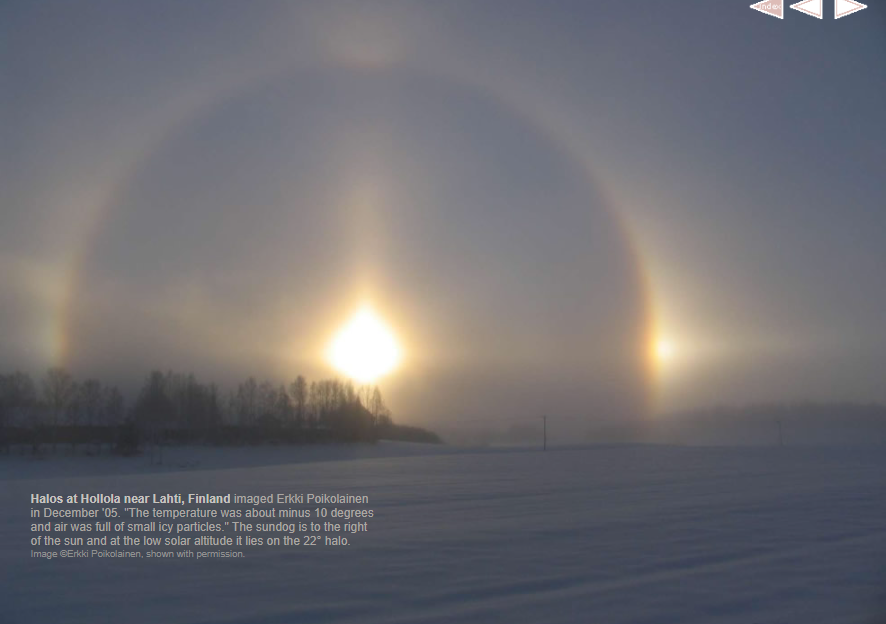Hollola Finland Halos
Exploring the Mesmerizing Halos of Hollola, Finland
In the enchanting winter wonderland of Hollola near Lahti, Finland, a captivating display of atmospheric optics known as halos can be witnessed. These awe-inspiring phenomena are a result of the interaction between sunlight and ice crystals suspended in the air. One intrepid observer, Erkki Poikolainen, captured a remarkable image of halos in December '05, showcasing their ethereal beauty. Let us delve deeper into the intricacies of these mesmerizing Hollola Finland Halos.
The Conditions that Give Rise to Halos
The formation of halos requires specific weather conditions. In this case, the temperature was around minus 10 degrees Celsius, creating an ideal environment for the presence of small icy particles in the air. These ice crystals serve as the canvas upon which sunlight paints its magical hues, resulting in the manifestation of halos.
The Sundog and the 22° Halo
In Poikolainen's image, a sundog can be observed to the right of the sun. Sundogs, also known as parhelia, are bright spots that appear on either side of the sun, often forming a halo-like shape. In this particular instance, due to the low solar altitude, the sundog lies on the 22° halo. The 22° halo is a circular halo that surrounds the sun and is located at an angle of approximately 22 degrees from the solar disk.
Unraveling the Mysteries of Halos
Halos have fascinated sky gazers for centuries, and their intricate patterns have puzzled scientists and observers alike. While their appearance may seem otherworldly, their formation can be explained through the interaction between sunlight and ice crystals. As sunlight passes through these hexagonal ice crystals, it refracts and reflects off their surfaces, resulting in a variety of optical phenomena.
The Role of Ice Crystals in Halo Formation
The shape and orientation of ice crystals play a crucial role in determining the type and appearance of halos. Hexagonal ice crystals are particularly common in halo formation, as their symmetrical structure leads to predictable patterns of light refraction and reflection. These crystals can take on various forms, such as columns, plates, or even complex combinations of these shapes, each contributing to the unique characteristics of the observed halos.
A Kaleidoscope of Halo Varieties
Halos come in a diverse range of forms, each exhibiting its own distinct pattern and appearance. Some of the most commonly observed halos include:
- The 22° halo: A circular halo located at an angle of approximately 22 degrees from the sun.
- Sundogs: Bright spots appearing on either side of the sun, often forming a halo-like shape.
- Circumzenithal arc: A vivid arc that arcs upwards from the sun, creating a smile-like shape.
- Parhelic circle: A faint circular halo that extends horizontally around the sun.
- Tangent arcs: Short arcs that touch the top and bottom of the 22° halo.
- Upper tangent arc: An arc that touches the top of the 22° halo.
Atmospheric Optics: A Playground for Light
The study of atmospheric optics provides a fascinating insight into the behavior of light as it interacts with various atmospheric phenomena. From rainbows to halos, these optical wonders showcase the intricate dance between sunlight and atmospheric particles. Researchers and enthusiasts continue to explore and document these phenomena, deepening our understanding of the mysteries that unfold above us.
The Beauty of Hollola Finland Halos
The image captured by Erkki Poikolainen offers a glimpse into the captivating beauty of halos in Hollola, Finland. Against the backdrop of a winter landscape, the delicate ice crystals suspended in the air transform sunlight into a symphony of colors and shapes. The interplay between light and ice creates a visual spectacle that enchants and mesmerizes all who have the privilege to witness it.
Embracing the Magic of Atmospheric Optics
The enchantment of atmospheric optics lies not only in the scientific understanding of their formation but also in the sense of wonder they evoke. Halos, like the ones witnessed in Hollola, Finland, remind us of the intricate and extraordinary nature of our world. They inspire us to look beyond the mundane and embrace the magic that can be found in the simplest of natural phenomena. So, next time you find yourself beneath a clear winter sky, take a moment to gaze upward and immerse yourself in the mesmerizing dance of light and ice crystals that create these captivating halos.

Halos at Hollola near Lahti, Finland imaged Erkki Poikolainen in December '05. "The temperature was about minus 10 degrees and air was full of small icy particles." The sundog is to the right of the sun and at the low solar altitude it lies on the 22° halo. Image ©Erkki Poikolainen, shown with permission.
Note: this article has been automatically converted from the old site and may not appear as intended. You can find the original article here.
Reference Atmospheric Optics
If you use any of the definitions, information, or data presented on Atmospheric Optics, please copy the link or reference below to properly credit us as the reference source. Thank you!
-
<a href="https://atoptics.co.uk/blog/hollola-finland-halos/">Hollola Finland Halos</a>
-
"Hollola Finland Halos". Atmospheric Optics. Accessed on November 26, 2024. https://atoptics.co.uk/blog/hollola-finland-halos/.
-
"Hollola Finland Halos". Atmospheric Optics, https://atoptics.co.uk/blog/hollola-finland-halos/. Accessed 26 November, 2024
-
Hollola Finland Halos. Atmospheric Optics. Retrieved from https://atoptics.co.uk/blog/hollola-finland-halos/.